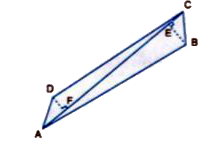One diagonal of a quadrilateral is 20 m long and the perpendiculars to it from the opposite vertices are 8.5 m and 11 m. Find the areaof the quadrilateral.
To find the area of the quadrilateral given the length of one diagonal and the perpendicular heights from the opposite vertices, we can follow these steps:
1. Identify the Given Values:
- Length of the diagonal (d) = 20 m
- Height from one vertex (h1) = 8.5 m
- Height from the opposite vertex (h2) = 11 m
2. Use the Area Formula for a Quadrilateral:
The area (A) of a quadrilateral can be calculated using the formula:
A=12×d×(h1+h2)
where:
- d is the length of the diagonal,
- h1 and h2 are the heights from the opposite vertices to the diagonal.
3. Substitute the Values into the Formula:
A=12×20×(8.5+11)
4. Calculate the Sum of the Heights:
h1+h2=8.5+11=19.5
5. Substitute the Sum Back into the Area Formula:
A=12×20×19.5
6. Calculate the Area:
- First, calculate 12×20=10.
- Then, multiply by the sum of the heights:
A=10×19.5=195
7. Final Result:
The area of the quadrilateral is:
A=195m2
- Length of the diagonal (d) = 20 m
- Height from one vertex (h1) = 8.5 m
- Height from the opposite vertex (h2) = 11 m
The area (A) of a quadrilateral can be calculated using the formula:
A=12×d×(h1+h2)
where:
- d is the length of the diagonal,
- h1 and h2 are the heights from the opposite vertices to the diagonal.
A=12×20×(8.5+11)
h1+h2=8.5+11=19.5
A=12×20×19.5
- First, calculate 12×20=10.
- Then, multiply by the sum of the heights:
A=10×19.5=195
The area of the quadrilateral is:
A=195m2
Topper's Solved these Questions
- LINEAR EQUATION IN ONE VARIABLEBOOK - RD SHARMA ENGLISHCHAPTER - LINEAR EQUATION IN ONE VARIABLEEXERCISE - All Questions
110 Videos
- MENSURATION-II (VOLUMES AND SURFACE AREAS OF A CUBOID AND A CUBE)BOOK - RD SHARMA ENGLISHCHAPTER - MENSURATION-II (VOLUMES AND SURFACE AREAS OF A CUBOID AND A CUBE)EXERCISE - All Questions
134 Videos
Similar Questions
The diagonal of a quadrilateral shaped field is 24 m and the perpendiculars dropped on it from the remaining opposite vertices are 8 m and 13 m. Find the area of the field.
View SolutionThe diagonal of a quadrilateral shaped field is 24 m and the perpendiculars dropped on it from the remaining opposite vertices are 8 m and 13 m. Find the area of the field.
View SolutionA quadrilateral has a diagonal of 26 cm. The lengths of perpendiculars on this diagonal from opposite vertices is 13 cm and 7 cm. Find the area of this quadrilateral.
View SolutionFind the area of a quadrilateral one of whose diagonals is 30 cm long and the perpendiculars from the other two vertices are 19 cm and 11 cm respectively.
View SolutionA field in the form of a parallelogram has one of its diagonals 42 m long the perpendicular distance of this diagonal from either of the outlying vertices is 10.8 m. Find the area of the field.
View SolutionA field in the form of a parallelogram has one of its diagonals 42 m long the perpendicular distance of this diagonal from either of the outlying vertices is 10.8 m. Find the area of the field.
View SolutionFind the area of a quadrilateral which has one diagonal measuring 22 cm, and the perpendiculars from the opposite vertices on this diagonal are 6 cm and 10 cm, respectively.
View SolutionThe ara of a quadrilateral is 780 sq. cm One of its diagonals measures 30 cm. If the perpendicular from one of the oppsite vertices on this diagonal is 15 cm, find the length of the perpendicular on this diagonal from the other vertex.
View SolutionFind the area of a quadrilateral ABCD whose diagonal AC is 25 cm long and the lengths of perpendiculars from opposite vertices B and D on AC are BE = 3.6 cm and DF = 2.4 cm .

View SolutionFind the area of a quadrilateral one of whose diagonal, is 25 cm long and the perpendicular from the other two vertices to this diagonal are 10 cm and 12 cm.
View Solution
